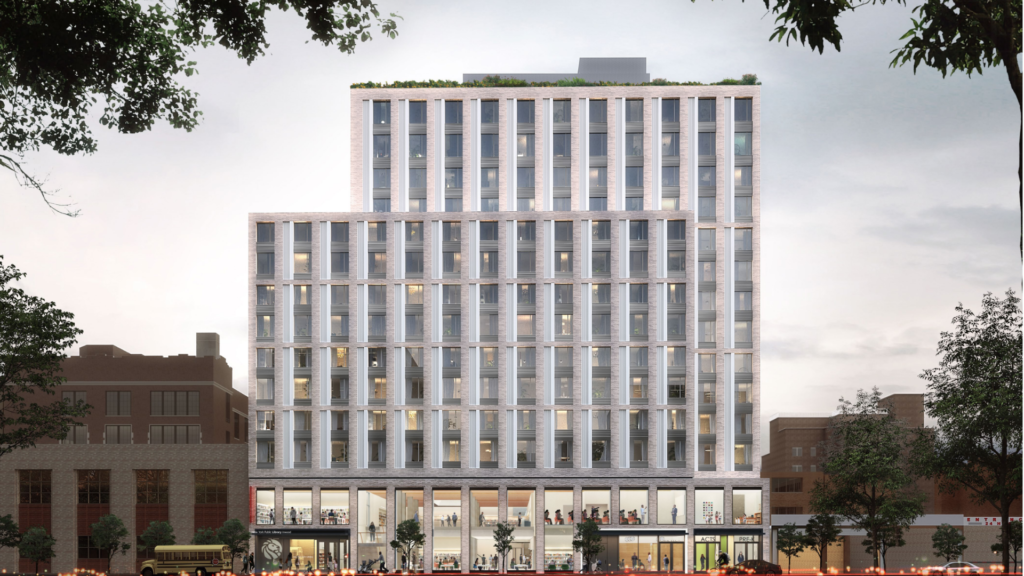“A stable and safe home can bend the arc of their lives, empowering them to secure steady employment and earn money and save. These 800 homes represent 800 opportunities to break the cycles of poverty.”
A rendering of The Eliza in Inwood, which the author says can be a model for housing projects open to foster youth. (Photo courtesy of The Children’s Village)
Every year, hundreds of young people in New York age out of the foster care system with nowhere to go. After experiencing the trauma of family separation, navigating the complexities of the system, and never getting the family the system promised them, they now face a daunting housing market with few resources and little support.
The numbers are alarming. Nearly one-third of the 429 young people who aged out of foster care in New York City in 2022 remained in this expensive, impersonal system past age 21 simply because they had no housing option. Nationally, up to 46 percent of former foster youth experience homelessness before the age of 26.
This isn’t just a housing shortage; it’s a policy failure. New York’s elected officials, housing developers, mission-driven investors, and social service providers must act now. Without stable housing, these young people face insurmountable barriers to education and employment, trapping them in cycles of intergenerational poverty.
The Children’s Village, in partnership with youth advocates and affordable housing developers, created a blueprint to end this cycle. The report, “Housing Justice for Young People Aging Out of Foster Care in New York City,” offers a five-year plan to create 800 new homes for youth exiting foster care—enough to effectively eliminate the foster care-to-homelessness pipeline in our city. The report was coauthored by The Center for Fair Futures, HR&A Advisers, and Good River Partners.
The report is powerful because it was shaped by those who grew up in foster care. These youth leaders who struggled to find housing after leaving foster care established a housing justice standard that guided our approach. They didn’t just identify the problem—they helped design the solution.
They reminded us that the vast majority—85 percent—of affordable housing continues to be built in our most burdened and racially segregated communities. And they urged us to break away this history of segregation by giving them the opportunity to experience the safety and joys of integration.
At The Children’s Village, we value their perspective. We know that living in a beautiful home that is affordable and located in a desirable neighborhood, that I would choose to live in, is a game changer. The research is clear—where you live and where your children go to school is the most powerful predictor of second generation success in the United States. Yes, it is location, location and location!
We tested this hypothesis of integration by building housing in integrated, desirable neighborhoods, and the results are overwhelming. Everyone does better when we learn to live together. This is true of all our housing developments, including our most recent success, The Eliza, a 14-story development in the racially integrated community of Inwood, that is available to all, including youth exiting foster care. It illustrates what is possible when we turn policy into progress, when nonprofits, investors and government agencies collaborate and fight to realize the promise of integration.
Yet, The Eliza also highlights the limitations of our current approach: it is difficult to do, it takes too long, and we are not building enough of these desirable homes. This report calls for innovative funding and policy changes to incentivize projects similar to The Eliza and a Home for Harlem Dowling to secure 800 new units for youth exiting foster care.
To construct these beautiful, integrated, desirable homes, we recommend blending private investment with mission-driven capital through a Fair Futures Housing Fund. This fund would mitigate risks and offset revenue limitations for investors, offering returns of 4-6 percent. This will accelerate the construction of new homes these young people urgently need.
We would also propose policies to leverage existing housing located in desirable communities, including the expanded use of master rental subsidy agreements (MRSAs). These arrangements allow nonprofits to work with landlords to “bank” apartments for voucher-holders, including young people aging out of care.
Additionally, we recommend loosening restrictions on city housing vouchers, making them transferable to nearby states, and creating a centralized hub with the city’s Administration for Children’s Services for young people to access housing assistance.
By constructing new affordable housing, leveraging existing housing, and simplifying the housing search, we can end the foster care-to-homelessness pipeline and provide just, quality housing in desirable neighborhoods for youth exiting the foster care system. A stable and safe home can bend the arc of their lives, empowering them to secure steady employment and earn money and save. These 800 homes represent 800 opportunities to break the cycles of poverty.
The solution is within our reach. To our elected officials, housing developers, investors, and fellow service providers: the blueprint is here. We can act now to end this intergenerational crisis.
Jeremy Kohomban is the president and CEO of The Children’s Village.
The post Opinion: How 800 Homes in Desirable Communities Could Disrupt a System-to -Homelessness Pipeline appeared first on City Limits.

